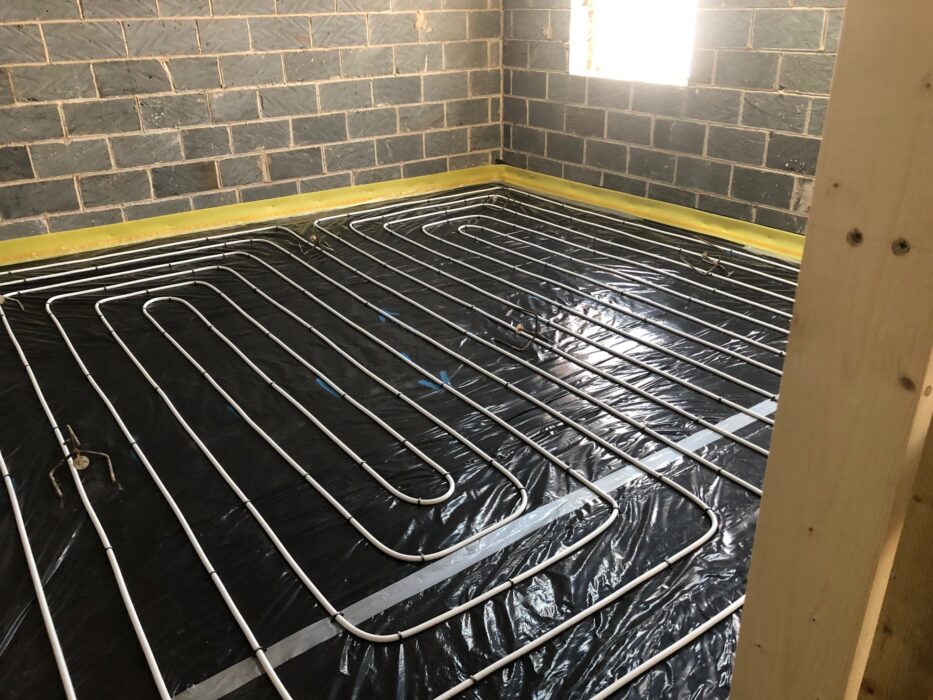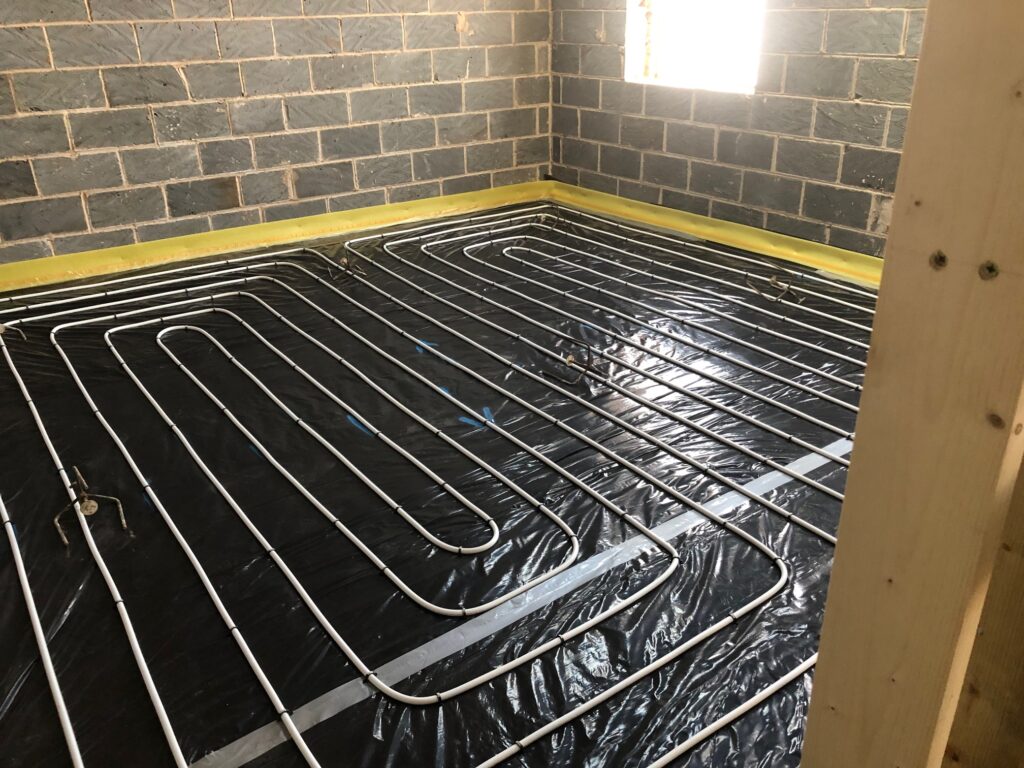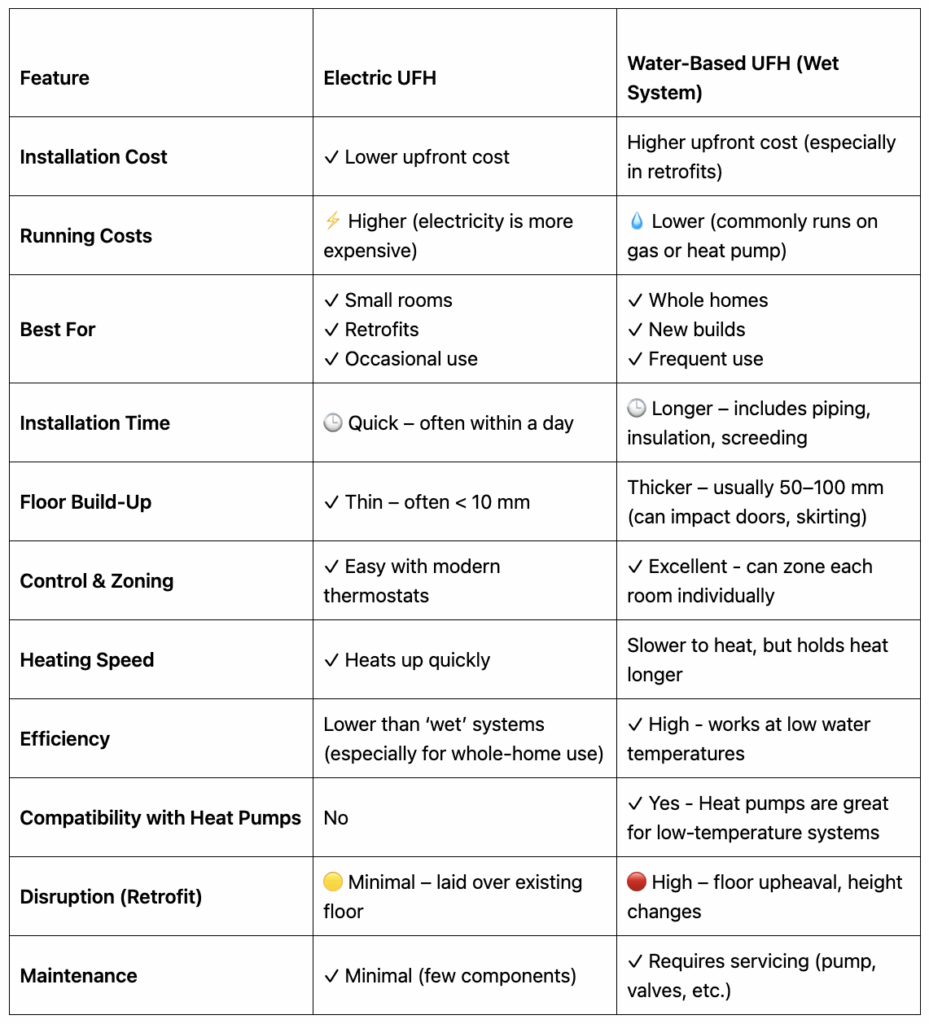
The Ultimate Guide to Underfloor Heating: Costs, Types & Benefits
Underfloor Heating (UFH) is gaining popularity both in new builds and renovations. The benefits? Comfortable and even heat distribution across different flooring types, along with energy efficiency. Plus, it’s a great space saver as it reduces the need for radiator units.
Here’s how underfloor heating could be a good idea for your home. We’ll cover the differences between electric and water UFH systems, outline the costs involved in running both systems, and offer tips on installation.
Key takeaways:
- Choosing underfloor heating depends on many factors, such as the energy source that powers your home, the size of the property, and budget
- Electric UFH is best for cheaper installs in smaller homes
- Water-based UFH is best for energy efficiency, lower running costs, and big spaces or new builds
Contents:
- What is Underfloor Heating? How Does it Work?
- Electric or Water-Based Underfloor Heating: Which is Best?
- Understanding Underfloor Heating Costs
- Designing and Installing Your Underfloor Heating System
- Tips for Choosing and Fitting Underfloor Heating
What is Underfloor Heating (UFH)?
As the name implies, underfloor heating is a method of warming a home from below the flooring. The UFH system is installed under the floor surface, providing consistent, comfortable heat underfoot. This warmth then rises gently and spreads, to create a cosy feel.
UFH typically puts less strain on boilers vs. traditional radiator systems as it operates at a lower temperature (around 40°C), compared to 65°C for radiators. It’s also possible to power UFH with renewable heating systems, like Heat Pumps and Solar Thermal.
How Does It Work?
Underfloor heating starts by warming the floor (either via electric cables or water-filled pipes). This energy passes through the air and is absorbed by surfaces, objects, and the people in the room, warming them, without heating the air first (how radiators do).
UFH can be either Electric or Water-Based. Here’s how each type works:

In the past, UFH was considered a luxury reserved for new builds or extensions. But innovations means it’s now a great replacement for radiators in many properties.
Electric or Water-Based Underfloor Heating: Which is Best?
Let’s look at the pros and cons of both types of UFH.
Why Choose Water-Based Underfloor Heating?
Key benefits include:
- Lower Running Costs: ‘Wet’ systems use warm water, typically heated by a Boiler or Heat Pump, and run at lower temperatures (around 35–45°C). Water is an excellent conductor of heat across large surfaces, and heating water is generally cheaper than electric UFH.
- Ideal for Larger Spaces or Multiple Rooms: (such as new builds or big renovations) water-based UFH distributes heat evenly across big spaces and can connect to central heating systems. It can also save space vs. fitting traditional radiators, meaning more options for placing floor-to-ceiling doors, windows, and kitchen units.
- Increased Comfort and Control: Expect a gentle, steady warmth. Modern systems are designed with a heating thermostat and ‘zones’ to keep temperatures even.

The Downside to Water-Based Underfloor Heating?
Installation is the main consideration of choosing a ‘wet’ UFH. While it’s efficient in the long term, water-based underfloor heating comes with higher upfront costs, especially in retrofits. Existing flooring usually needs taking up, new pipes installing, and the floor levels adjusting.
Electric Underfloor Heating: The Pros
These include:
- Quick and Simple Installation: Electric UFH systems are thinner and can be installed under many floors, without needing pipework or screeding. They don’t add much height to your floor (usually less than 10mm), so they’re perfect for retrofits and renovations where doors, skirting boards, and sockets are in place. Save space by moving away from traditional radiators in the home.
- Heat Up In Good Time: Electric UFH warms faster than water-based systems, making it ideal for quick heat.
- Low Maintenance: Electric UFH has fewer moving parts compared to water-based systems. There are no pumps, valves, or water circuits to service, which generally means less maintenance.
Electric vs. Water-Based Underfloor Heating Comparison
The table below breaks it down further.

Understanding Underfloor Heating Costs in the UK
The Running Costs of Underfloor Heating
Many factors determine the costs of heating your home with UFH, such as:
- Property size
- How much of the home uses UFH
- Insulation
- Desired temperature
- Using a timer and planning when the heating comes on
- Electricity / gas prices
- The type of system (electric or water-based UFH)
Generally, electric UFH costs more to run than water-based systems, because electricity has a higher cost per kWh (kilowatt hour) vs. gas, which is often used to heat water-based systems.
A water-based system running on gas or renewable energy is the cheapest way to power UFH, especially when it comes to large rooms or entire buildings.
The Cost of Electric Underfloor Heating per m2
In reality, an electric underfloor heating system can cost three to four times more to run vs. radiators or ‘wet’ systems. Be sure to consider if electric UFH is right for you.
Say it costs 24.5 pence per kWh of electricity, the cost to run electric UFH would be anywhere between £373 and £1,469 per year for a room sized between 10m2 and 30m2.
Water Underfloor Heating Cost per m2
Typically, it’s cheaper to run a water-based underfloor heating system.
For example, if gas cost 6.04 pence per kWh, running a ‘wet’ underfloor heating system for a year could cost £134 to £392 per year for rooms between 10m2 and 30m2 in size.
Tips for Saving Money while Using Underfloor Heating
Here are some suggestions for keeping costs down:
Proper Insulation and Sealing so heat can’t escape out windows, doors, or walls not well insulated.
Lower the Temperature to around 18–21°C – the range UFH works best. Even distribution means you’ll still feel comfortable at a lower setting than with radiators.
Use a Smart Thermostat to set schedules, so the heating is only on when you’re home. Smart thermostats let you control room temperatures individually and avoid wasting energy heating unused spaces.
Avoid Covering the Floor with heavy rugs and furniture that could block heat from reaching the whole room. Keep floors clear where possible, so heat can rise and spread.
Regular Maintenance: Keep your underfloor heating running as it should be. This is especially important for ‘wet’ systems with more complex parts.

Designing and Installing Your Underfloor Heating
Whether doing up your home or designing a brand new build, electric underfloor heating will prove cheaper upfront.
New Build UFH Costs
In new builds, the cost of installing electric underfloor heating usually ranges from £2,000 to £6,500, depending on the type of UFH and other factors like labour, materials, the size of the property, and the floor space you’re heating.
Buying and fitting electric systems in new builds costs around £2,000 to £2,600. While a ‘wet’ UFH in a new build will cost more like £5,500 to £6,500.
Renovation UFH Costs
Retro-fitting UFH in a home can cost between £4,000 and £9,000, with the same variables at play (labour costs, property size, the type of system, etc.).
Tips for Choosing and Installing Underfloor Heating
Choosing the right system (or if UFH is for you) isn’t easy. So, here are some tips to help:
- Choose the Right System for Your Space: Consider how often the room will be used. Electric UFH is best for small areas, single rooms, and retrofits. Water-based UFH is best for larger areas, whole homes, and new builds.
- Plan Around Floor Height: UFH systems (especially water-based) add height to the floor. Check there will still be space for your doors to open and the skirting boards to sit.
- Think About Floor Type: UFH works well under many materials (tile, stone, laminate, and engineered wood). It can’t go under thick carpets, solid wood, and some types of vinyl flooring.
- Check for Building Regulations: UFH must meet certain energy efficiency standards. Your installer should be aware of the ‘Part L’ regulations in the UK, for example.
- Hire a Reputable Installer: Hire experienced fitters, who understand the layout, zoning, and screeding process involved in UFH.
How Can We Help?
Once you’ve made a choice or if you’d like a conversation about options, our Gas Safe‑registered engineers are here to assist. Whether you choose water-based or electric underfloor heating, traditional radiators, or another heating option, we’ll make sure your home stays warm, comfortable, and energy-efficient.
We deliver tailored heating systems designed for your property and lifestyle, with professional plumbers and electricians you can trust. Our friendly team will guide you through the whole process, from the initial consultation to final fit with ongoing support.
Ready to take the next step? We can give you a quote right away. Give us a call or book your consultation online today.
FAQs About Underfloor Heating
Still got questions about UFH? Find out the answers to frequently asked questions.
Is it cheaper to leave underfloor heating on constantly?
It’s generally cheaper to leave water-based underfloor heating on at a lower, consistent temperature. This is because these systems heat up and cool down slowly.
Whereas if you have an electric UFH, which responds faster, you can turn it on / off as needed, especially in rooms used intermittently, like bathrooms.
Which is cheaper to run, underfloor heating or radiators?
Generally, water-based underfloor heating systems are cheaper to run than radiators, and can help consumers save up to 25% on their energy bills. This is because they operate at lower temperatures and distribute heat evenly. However, electric underfloor heating can be more expensive to run than radiators, due to the higher cost of electricity.
What furniture can you not put on underfloor heating?
Placing bulky furniture over underfloor heating can block heat from circulating properly. This reduces the system’s efficiency and may even cause damage over time. Heavy, solid pieces like sofas, bookcases, and beds are especially problematic, as they create a barrier that traps heat beneath them, instead of allowing it to warm the room.


